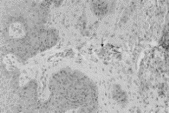inflammed muscles
Myositis
😏cidpusa.org
Severe myositis, as evidenced by the CK, does not necessarily imply diffuse myositis, as demonstrated in this case by the MRI. Indeed a patchy distribution on MRI is characteristic of these diseases, and explains why a normal muscle biopsy is not incompatible with severe disease. The lack of inflammatory cells in the muscle biopsy in this case may also be due to the vasculitic basis of dermatomyositis, leading to ischaemic muscle necrosis 3. In other situations a normal biopsy may result from steroid treatment. However, in this case, central nucleation is a feature of regenerating muscle fibres, and therefore demonstrates an active pathological state.
In our series of 78 patients, 23 (29%) had pharyngeal or oesophageal involvement. Intravenous Ig was used to treat dysphagia in the four most severe cases, with complete recovery occurring in all, including the case described. Cyclosporin was used in this case rather than azathioprine as it is available in liquid form and is therefore more convenient for long‐term use in patients with a PEG tube. This case illustrates the point that patients may need two or more courses of i.v. Ig before they regain normal swallowing. The use of i.v. Ig is discussed in detail in the Discussion. Case 2 Diagnosis Dermatomyositis, calcinosis, cerebellar vasculitis.
Treatment: Prednisolone, azathioprine, i.v. Ig, diltiazem.
Following initial treatment with prednisolone and azathioprine the weakness slowly improved and the serum CK fell to 98 U/l. Prednisolone was successfully tapered to a low dose and she remained well. Three years later she developed calcinosis in the tissues of her buttocks and upper arms and a skin biopsy revealed vasculitis (Fig. 1⇔). A year later she relapsed, became weak, the ESR rose to 58 mm/h and the CK remained normal. An MRI of both thighs showed patchy increased signal on inversion recovery images, and muscle biopsy from the thigh revealed basophilic fibres with lymphocytic infiltration. At the same time she developed ataxia and dizziness, and an MRI of the brain revealed a left cerebellar hemisphere infarct (Fig. 2 ⇔), which was presumed to be due to vasculitis. She received two courses of i.v. Ig (2 g/kg) resulting in an improvement in muscle weakness; and dizziness resolved spontaneously. The calcinosis was treated with diltiazem, up to 360 mg daily, but did not diminish.
Comment
The ESR at presentation was not as high as might be expected from the CK, and this illustrates our comments after case 1 regarding the ESR in inflammatory muscle diseases. The initial muscle biopsy from this patient was normal. This reflects the patchy nature of the myositis as shown subsequently in this patient on muscle MRI, and confirmed on the second biopsy. Basophilic fibres indicate regenerating muscle and this is a feature of an active pathological state. The diagnosis of relapse was not supported by the CK but was clearly demonstrated by the MRI and biopsy. The role of MRI in long‐term management is discussed in detail in the Discussion.Calcinosis is a feature of dermatomyositis that is more frequently recognized in children. We have one other adult case of dermatomyositis with calcinosis in our series, in which, in contrast to this report, the calcinosis improved considerably following treatment with the calcium channel blocker diltiazem.
The primary pathological process in dermatomyositis is vasculitis within skeletal muscle , and is demonstrated in this case in the skin biopsy. Systemic vasculitis is also reported, but involvement of the central nervous system (CNS) is rare and more classically described in children . In this case the appearances on the MRI were of ischaemia, which, in the absence of risk factors for thromboembolic disease, we feel was most likely to be due to vasculitis. We have seven other cases of systemic vasculitis in our series (9%), and one other case of CNS vasculitis, all in patients with dermatomyositis.
 View larger version:Fig. 1.
View larger version:Fig. 1.

😏